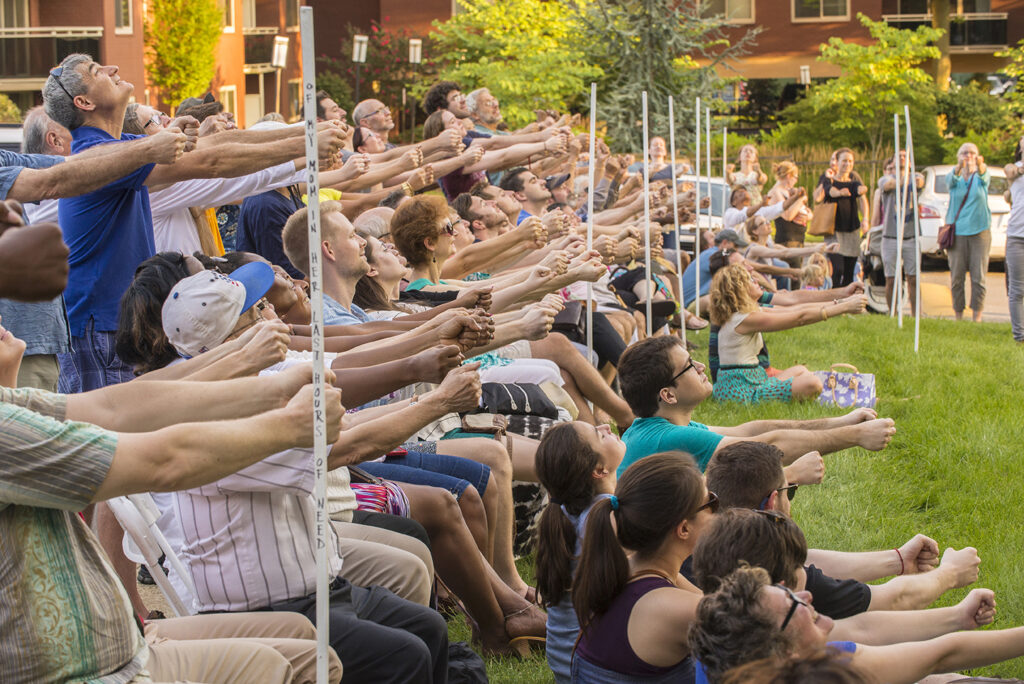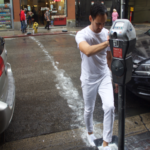A stretch of New Hampshire Avenue in Takoma Park, MD just outside Washington, DC was a typical auto-oriented street designed to move commuters through a place quickly, making walking, rolling, and biking for residents not just difficult but unsafe. With an invite from the city, a dance group harnessed the power of arts and culture to shift the narrative of a place defined by its transportation challenges.
The challenge
Adjacent to Washington, DC’s northeast border lies the City of Takoma Park, a multi-ethnic community bounded on the east by New Hampshire Avenue, a six-lane, a heavily trafficked state highway that runs through the middle of a vibrant community with large immigrant populations. Developed to prioritize vehicular commuting traffic over pedestrians, it poses an obstacle to social connection and is dangerous for those who walk along it or cross it. The roadway design of corridors like New Hampshire Avenue is a main contributing factor to the steep rise of pedestrian fatalities in the U.S. In the last decade (2010 – 2019), over 53,435 people were hit and killed by drivers.

Over the years, a large number of new residents from India, El Salvador, China, Ethiopia, and other countries have moved to the corridor and opened small businesses along the avenue. The corridor boasts multiple Halal butchers, a weekly farmer’s market run by the Latino community, and the oldest sari store in the United States. These newer residents walk and ride public transit more frequently than legacy residents of Takoma Park, and the avenue is dangerous for residents trying to navigate the busy thoroughfare because of its auto-centric design. As such, this has also limited its potential to thrive economically as the main street or commercial hub of the community.
The project
To improve the visitor and resident experience and safety along New Hampshire Avenue, the Housing and Community Development Department of the City of Takoma Park invited community-engaged dance company Dance Exchange, led by Executive Artistic Director Cassie Meador and founded by renowned artist Liz Lerman, to develop a project that could shift the narrative of a place defined by its transportation challenges. Building on work the City of Takoma Park had already begun through the “New Ave” initiative, Dance Exchange’s New Hampshire Ave: This is a Place to… project used both a “traveling” strategy that encompassed the length of the corridor, and a “gathering” strategy that drew together participants around the avenue’s central green space, as detailed in the National Endowment for the Arts’ How to Do Creative Placemaking.


Participants included residents, community leaders, property managers, and business owners. Dance Exchange and their partners invited city staff and the people who live and work along the corridor to explore and share about their relationship to each other and the avenue, using the tools of dance, visual art, sculpture, installation, photography, storytelling, performance, dance-making, and the project’s signature colorful chairs out along the avenue. The project kicked off in 2014 with a one-day community festival along New Hampshire Avenue where attendees created dances about their journeys to, and life along, the Avenue. Throughout the course of over a year, New Hampshire Ave: This is a Place to… explored the project’s six main questions:
- What brings us to this place?
- What traditions do we carry here?
- Which do we leave behind?
- How do our diverse experiences and journeys to the corridor shape the place today?
- What keeps us here?
- What do we hope for the future of the avenue?
Concurrently, Dance Exchange held a series of workshops for staff of the Takoma Park Housing and Community Development Department that focused on improving the ways in which the city talks to residents during planning processes. Through techniques that included Liz Lerman’s Critical Response Process (CRP), the workshops focused on incorporating local cultural feedback in a planning process, the pressing challenges and opportunities within city management and planning, and the opportunities for creative practices within city administration and planning.
The results

By sharing new narratives about New Hampshire Avenue through arts-based workshops and performances, Dance Exchange revealed to partners, including the City of Takoma Park’s Housing and Community Development and Planning Departments, the underlying human story of what the avenue means for those who use it most. These workshops and artistic interventions were meant to be shared between citizens and city staff to plant the seeds for new processes. Amanda Newman, who served as Dance Exchange’s resident artist, communications coordinator, and youth programs facilitator, recalls that when they began the project the notion of creative participation by city staff was uncommon, but that the artistic interventions “were not for the city staff, but with the city staff [emphasis added].”
These human stories revealed the need to create a safer and more inclusive experience for those who are not simply passing through the corridor. As Cassie Meador, Artistic Director at Dance Exchange explains:
In Takoma Park, the design of transportation impacted the identity [of the corridor] and the way that people used the space, even though that’s only a small element of what makes up the place. New Hampshire Ave is a lot of things, but people living and working beyond the Ave more often define it by the transportation elements.
Looking back, Meador believes that having city staff make art alongside neighbors expanded the city’s understanding of New Hampshire Avenue’s role in residents’ lives.

One of the challenges, identified by the artists, was measuring concrete project outcomes. This is difficult to do with any project that aims to shift culutre, but particularly challenging when the project spans a short time frame. One potential lesson is that projects like these may require longer timelines.
While this project helped the city evolve its culture of feedback in the planning process, the city is still fighting uphill against the state to make a dangerous six-lane highway safer and more accommodating. If you visit New Hampshire Avenue today, you’ll see a dangerous slip lane by the new bus station near the university, numerous barriers that keep people from crossing where they want, and plenty of evidence of the the continued auto-first design decisions that have been made in last five years. To improve these corridors is a struggle, but building this sort of people first culture on the ground is a great first step.











